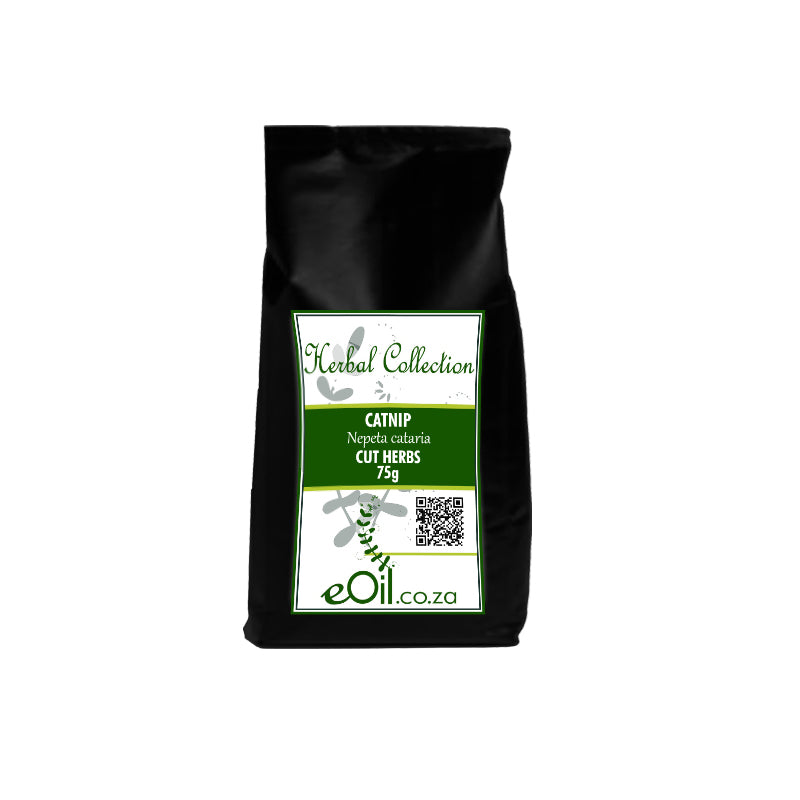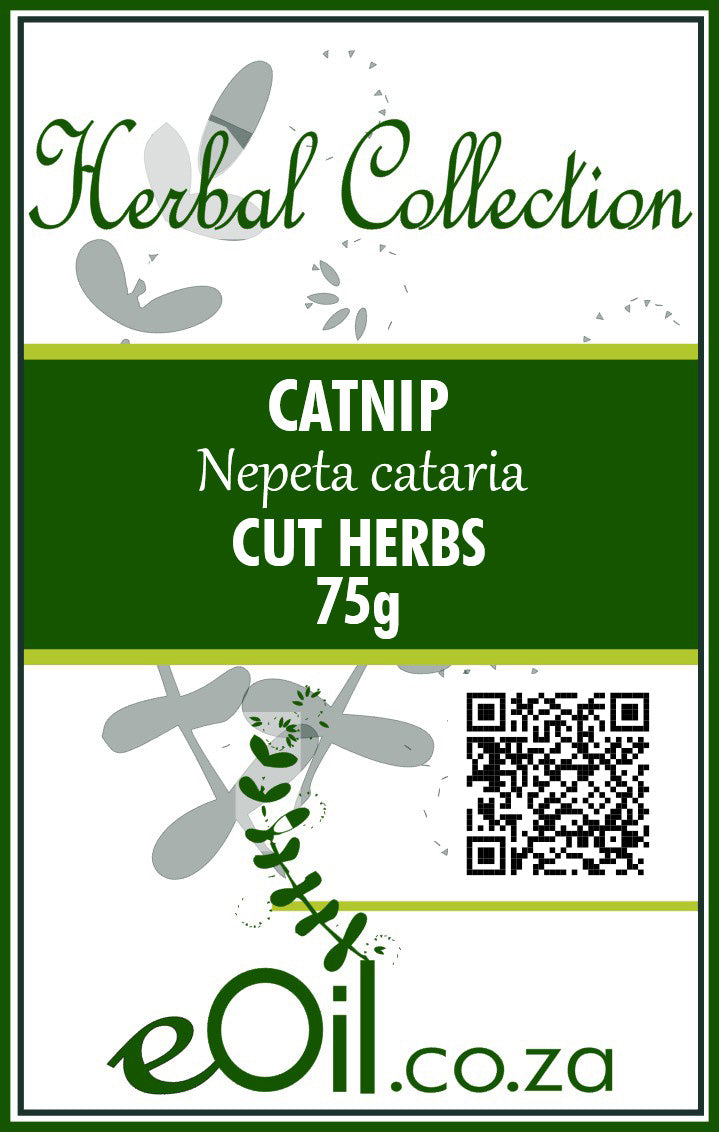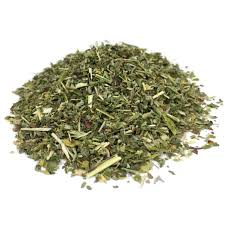Catnip Herb Cut - Herbal Collection
Catnip Herb Cut - Herbal Collection - 75 GR is backordered and will ship as soon as it is back in stock.
Description
Description
Catnip Herb Cut (Nepeta cataria) is a natural herb from the mint family, renowned for its ability to delight cats and its gentle, calming use in traditional herbal teas.
Naturally aromatic, it can help create soothing infusions and enrich your pet’s environment. Pure, versatile, and free from additives
TRADITIONALLY USED FOR
Catnip (Nepeta cataria) is a perennial herb belonging to the mint family.
It is native to Europe, Asia, and Africa and has been used for centuries for its medicinal and recreational properties.
Catnip is well-known for its effect on cats, but it also has various traditional uses, properties, and benefits for humans:
- Relaxation and stress relief: Catnip has calming and soothing effects on the nervous system, making it useful for reducing stress, anxiety, and tension. It has traditionally been used in herbal teas or as a tincture to promote relaxation.
- Sleep aid: Catnip is considered a mild sedative, which can help improve sleep quality and treat insomnia. Drinking a cup of catnip tea before bedtime may help you fall asleep faster and stay asleep longer.
- Digestive health: Catnip has been used in traditional medicine to relieve various digestive issues, including indigestion, gas, bloating, and stomach cramps. Its antispasmodic properties can help relax the muscles of the gastrointestinal tract.
- Respiratory health: Catnip has been used as a natural remedy for colds, coughs, and other respiratory issues. Its decongestant and expectorant properties can help loosen and expel mucus, while its antispasmodic effects may help alleviate coughing.
- Pain relief: Catnip has analgesic and anti-inflammatory properties, making it potentially useful for relieving pain, including headaches, migraines, toothaches, and menstrual cramps.
- Insect repellent: Catnip contains a compound called nepetalactone, which has been found to repel insects like mosquitoes, flies, and cockroaches. Crushed catnip leaves or catnip essential oil can be applied to the skin or used in a spray to deter insects.
- Antimicrobial properties: Catnip has been shown to possess antimicrobial properties against various bacteria and fungi, which may contribute to its use in traditional medicine for treating infections and promoting wound healing.
- Skin health: Catnip's anti-inflammatory and antiseptic properties may help soothe skin irritations, rashes, and minor burns. A poultice made from catnip leaves or a diluted solution of catnip essential oil can be applied topically to the affected area.
It is essential to note that while catnip is generally considered safe for most people, some individuals may experience allergic reactions or side effects, such as drowsiness, nausea, or vomiting. Pregnant women and nursing mothers should avoid using catnip, as it may cause uterine contractions or affect milk production. If you have any concerns or underlying health conditions, consult with a healthcare professional before incorporating catnip into your wellness routine.
INFORMATION
Source : http://www.wikiphyto.org/wiki/Cataire
Reference on http://www.wikiphyto.org
Translation in English by Google Translate (go to the page of the source linked | on Chrome cellphones go on the 3 dots on the top right and select translate in your preferred language | on laptop right click your mouse and select option translate when hoovering on the page
plant name
Catmint , Catnip , catmint (English)
International Latin denomination
botanical family
Lamiaceae
Description and habitat
- Aromatic, fluffy perennial, 1 m tall, with greyish-green, heart-shaped leaves with a mint smell
- White flowers in whorls, dotted with purple
- Native to Europe, acclimatized in North America
- Dry paths, mountainous regions, up to 1500 m altitude
History and tradition
- Known since Antiquity, its cultivation was encouraged in the royal domains of the time of Charlemagne (it is part of the "Capitular De Villis")
- Used to treat fevers during the Middle Ages
- According to the dictionary of Trévoux (18th century), it is a "strong aperitif plant", suitable for causing ordinary and curing vapours"
- The herbal tea has a pleasant taste, unlike another catnip , valerian .
- Different species of Nepeta sp. are used in traditional medicine as an antimicrobial, anti-inflammatory, sedative, relaxant, cholesterol-lowering, anti-asthmatic, carminative, diuretic, diaphoretic, febrifuge, vermifuge, herbicide, insecticide and insect repellent, depending on their composition [1]
Parts used
- Flowering aerial parts
Dosage forms available
- Mother tincture of Nepeta cataria aerial parts
Usual dosages
Composition
Main components of the plant
- Iridoids : nepetalactone
- Tannins , flavonoids , phenolic acids
- Essential oil with citronellol , geraniol , carvacrol , thymol
- actinidin
Main components of buds or young shoots
Main components of essential oil
- Monoterpene alcohols : citronellol , geraniol
- Phenols : carvacrol , thymol
- Lactone : nepetalactone
- Oxide : 1,8-cineole
- Monoterpenols : alpha-humulene , alpha-pinene
- Esters : geranyl acetate
- There are two main chemotypes of essential oils : nepetalactone and 1,8-cineole +/- linalool [1]
Properties
Plant properties
- Analgesic, slightly narcotic
- Antispasmodic and relaxing
- Diaphoretic (promotes perspiration) and febrifuge
- Facilitates gas expulsion and digestion
- Nepetalactone is highly insect repellent, it repels various species of mosquitoes including Anopheles [2] , Aedes [3] and Culex [4] , Dermatophagoides mites [5] , in synergy with nepetalactone isomers and (E)- (1R,9S)-caryophyllene , present in the plant
- Aphrodisiac for cats
- Antidepressant, antidiabetic, analgesic, anti-inflammatory, antioxidant, hypolipidemic, cardioprotective properties, depending on the species of the genus Nepeta [1]
Bud properties
Properties of essential oil
- Anti-infectious against Gram-positive ( Staphylococcus aureus ) and Gram-negative ( Pseudomonas aeruginosa ) bacteria often responsible for nosocomial diseases [6] , as well as affections of the oral cavity [7]
- Fungistatic and bacteriostatic [8]
- Antioxidant [9]
- Spasmolytic, antiasthmatic, by likely inhibition of calcium channels and papaverine-like activity [10]
Directions
Indications of the whole plant (phytotherapy)
- Colds, flu, fevers in children (associated with black elderberry , herbal tea sweetened with honey), asthmatic and spastic bronchitis
- Indigestion, colic, digestive headaches
- menopausal hot flashes
- Rheumatism and arthritis in local applications
Indications of the bud (gemmotherapy)
Specific indications of essential oil (aromatherapy)
Known or suspected mode of action
- Iridoids take their name from that of the Iridomirmex ants which possess these molecules playing a role in their defense mechanisms, many of them are anti-inflammatory
- Actinidin is an attractor for cats
Usual formulations
Regulations
Possible side effects and precautions for use
- None known, no prolonged use as a precaution
Bibliographic references
- ↑ Aller à :1.0 1.1 and 1.2 Bahare Salehi, Marco Valussi, Arun Kumar Jugran, Miquel Martorell, Karina Ramírez-Alarcón, Zorica Z. Stojanović-Radić, Hubert Antolak, Dorota Kręgiel, Ksenija S. Mileski, Mehdi Sharifi- Rad, William N. Setzer, María de la Luz Cádiz-Gurrea, Antonio Segura-Carretero, Bilge Şener, Javad Sharifi-Rad. Nepeta species: From farm to food applications and phytotherapy. Trends in Food Science & Technology 80 (2018) 104–122
- Aller↑ Birkett MA, Hassanali A, Hoglund S, Pettersson J, Pickett JA. Repellent activity of catmint, Nepeta cataria, and iridoid nepetalactone isomers against Afro-tropical mosquitoes, ixodid ticks and red poultry mites. Phytochemistry. 2011 Jan;72(1):109-14. doi: 10.1016/j.phytochem.2010.09.016. PMID 21056438
- Aller↑ Polsomboon S, Grieco JP, Achee NL, Chauhan KR, Tanasinchayakul S, Pothikasikorn J, Chareonviriyaphap T. Behavioral responses of catnip (Nepeta cataria) by two species of mosquitoes, Aedes aegypti and Anopheles harrisoni, in Thailand. J Am Mosq Control Assoc. 2008 Dec;24(4):513-9. PMID 19181058
- Aller↑ Gkinis G, Michaelakis A, Koliopoulos G, Ioannou E, Tzakou O, Roussis V. Evaluation of the repellent effects of Nepeta parnassica extract, essential oil, and its major nepetalactone metabolite against mosquitoes. Parasitol Res. 2014 Mar;113(3):1127-34. doi: 10.1007/s00436-013-3750-3. PMID 24449446
- Aller↑ Khan MA, Jones I, Loza-Reyes E, Cameron MM, Pickett JA, Birkett MA. Interference in foraging behavior of European and American house dust mites Dermatophagoides pteronyssinus and Dermatophagoides farinae (Acari: Pyroglyphidae) by catmint, Nepeta cataria (Lamiaceae). Exp Appl Acarol. 2012 May;57(1):65-74. doi: 10.1007/s10493-012-9532-2. PMID 22382713
- Aller↑ V.-G. from Billerbeck. Essential oils and antibiotic resistant bacteria. Essential oils and antibiotic-resistant bacteria. Phytotherapy, Volume 5, Number 5, 249-253
- Aller↑ Zomorodian K, Saharkhiz MJ, Rahimi MJ, Shariatifard S, Pakshir K, Khashei R. Chemical Composition and Antimicrobial Activities of Essential Oil of Nepeta Cataria L. Against Common Causes of Oral Infections. Journal of Dentistry (Tehran, Iran). 2013;10(4):329-337.
- Aller↑ C. Bourrel, F. Perineau, G. Michel & JM Bessiere. Catnip (Nepeta cataria L.) Essential Oil: Analysis of Chemical Constituents, Bacteriostatic and Fungistatic Properties. Journal of Essential Oil Research, Volume 5, 1993 - Issue 2, Pages 159-167 | Received 01 Mar 1992, Published online: 28 Nov 2011 [1]
- Aller↑ Adiguzel A, Ozer H, Sokmen M, Gulluce M, Sokmen A, Kilic H, Sahin F, Baris O. Antimicrobial and antioxidant activity of the essential oil and methanol extract of Nepeta cataria. Pol J Microbiol. 2009;58(1):69-76. PMID 19469289
- Aller↑ Gilani AH, Shah AJ, Zubair A, Khalid S, Kiani J, Ahmed A, Rasheed M, Ahmad VU. Chemical composition and mechanisms underlying the spasmolytic and bronchodilatory properties of the essential oil of Nepeta cataria L. J Ethnopharmacol. 2009 Jan 30;121(3):405-11. doi: 10.1016/j.jep.2008.11.004. PMID 19041706
- Modnicki D, Tokar M, Klimek B. Flavonoids and phenolic acids of Nepeta cataria L. var. citriodora (Becker) Balb. (Lamiaceae). Acta Pol Pharm. 2007 May-Jun;64(3):247-52. PMID 17695148
- Sarac N, Ugur A. The in vitro antimicrobial activities of the essential oils of some Lamiaceae species from Turkey. J Med Food. 2009 Aug;12(4):902-7. PMID 19735193
CAUTION
Store in a cool, dry place, away from light. Keep tightly closed, away from the reach of Children and pets.
Do not exceed the daily dose.
This product is not intended to prevent or cure any form of illness or disease.
If you are pregnant or nursing ; If you have a medical condition or are in the course of medical treatment ; If you are programmed for theater/operation in the near future, please consult your healthcare practitioner before using this product.
This product cannot replace a varied and balanced diet and a healthy lifestyle.
This product has not been evaluated by the SAHPRA for its quality, safety or intended use.
For More Information please check our General Safety Herbal products Page






